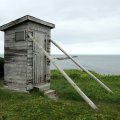PARC NATIONAL DU GROS-MORNE
Parc avec de remarquables formations géologiques, une flore et une faune variées et proposant diverses activités en plein air.
Joyau de l'île, inscrit au patrimoine mondial de l'UNESCO, ce parc s'étire sur 1 805 km², en bordure de la longue péninsule septentrionale. Il jouit d'une renommée internationale en raison de l'ancienneté exceptionnelle de sa formation géologique, remontant à 1 250 millions d'années, et des paysages grandioses qu'offrent les montagnes tabulaires des Long Range, entaillées de fjords. Sur l'étroite bande littorale, se succèdent petits villages de pêcheurs (Rocky Harbour, Lobster Cove, Baker's Brook, Sally's Cove, St. Pauls), falaises, anses de sable ou de galets. Le parc possède deux reliefs très différents l'un de l'autre : une plaine littorale en bordure du golfe du Saint-Laurent et un plateau alpin constitué par le sommet des monts Long Range. Ils servent d'habitats à une flore et à une faune variées, constituant un assemblage unique d'espèces des zones tempérées, boréales et arctiques.
Bonne Bay. Il s'agit là d'un profond fjord d'eau de mer se séparant en plusieurs bras, dont East Arm et South Arm. Le South Arm présente de magnifiques vues sur les villages de pêcheurs surplombés par les hauteurs tabulaires des Tablelands (altitude : 600 mètres), aux roches nues d'ocre rouge sorties de l'écorce terrestre. Près de Woody Point, un belvédère avec panneaux explicatifs offre une large vue de ces formations. Un sentier permet de pénétrer au cœur des Tablelands.
Lobster Cove Head. Il est bien connu pour son phare. Son cap comprend des sentiers menant vers des milieux côtiers et des forêts de tuckamores (conifères tordus par les vents marins). Le cap est l'un des meilleurs endroits dans le parc d'où observer les baleines et les couleurs phénoménales d'un coucher de soleil.
Broom Point. On y retrouve des installations de pêche traditionnelle qui reflètent la vie des familles de pêcheurs côtiers de Terre-Neuve. Expositions sur la pêche, visites guidées et activités d'interprétation y sont proposées.
Activités de plein air. On y pratique entre autres la randonnée (principale activité du parc), le kayak de mer, le vélo de montagne, le ski de fond et la raquette. Avec son réseau de plus de 100 km de sentiers, le parc offre une vingtaine de randonnées de tous niveaux, des promenades faciles à faire en famille aux randonnées les plus difficiles pour marcheurs chevronnés. Quelques randonnées faciles : Broom Point (1 km aller-retour), Chutes Southeast Brook (1 km aller-retour, dans les bois jusqu'à des chutes spectaculaires), Green Point (3 km sens unique, sentier côtier), Etang Berry Head (boucle de 2 km, tourbières, forêt), Etang Berry Hill (boucle de 2 km, étangs, oiseaux, grenouilles), Lobster Cove Head (boucle de 1 km, plage, maison du gardien du phare avec exposition). L'excursion aux Tablelands (4 km aller-retour, difficulté moyenne) permet de voir une géologie et une flore exceptionnelles. La randonnée qui permet d'atteindre le sommet du Gros-Morne (altitude 806 mètres) - 16 km, 7 à 8 heures de marche, niveau difficile - vous fera découvrir une végétation arctique-alpine et une faune particulière (lièvre arctique, lagopède).
Hébergement. Le parc compte cinq terrains de camping, des tentes oTENTik de type prêt-à-camper et des chalets rustiques. À noter que des hébergements indépendants sont également offerts par des entrepreneurs privés, notamment à Trout River, Woody Point, Glenburnie-Birchy Head-Shoal Brook, Wiltondale, Norris Point, Rocky Harbour et Cow Head.
Le saviez-vous ? Cet avis a été rédigé par nos auteurs professionnels.
Avis des membres sur PARC NATIONAL DU GROS-MORNE
Les notes et les avis ci-dessous reflètent les opinions subjectives des membres et non l'avis du Petit Futé.




